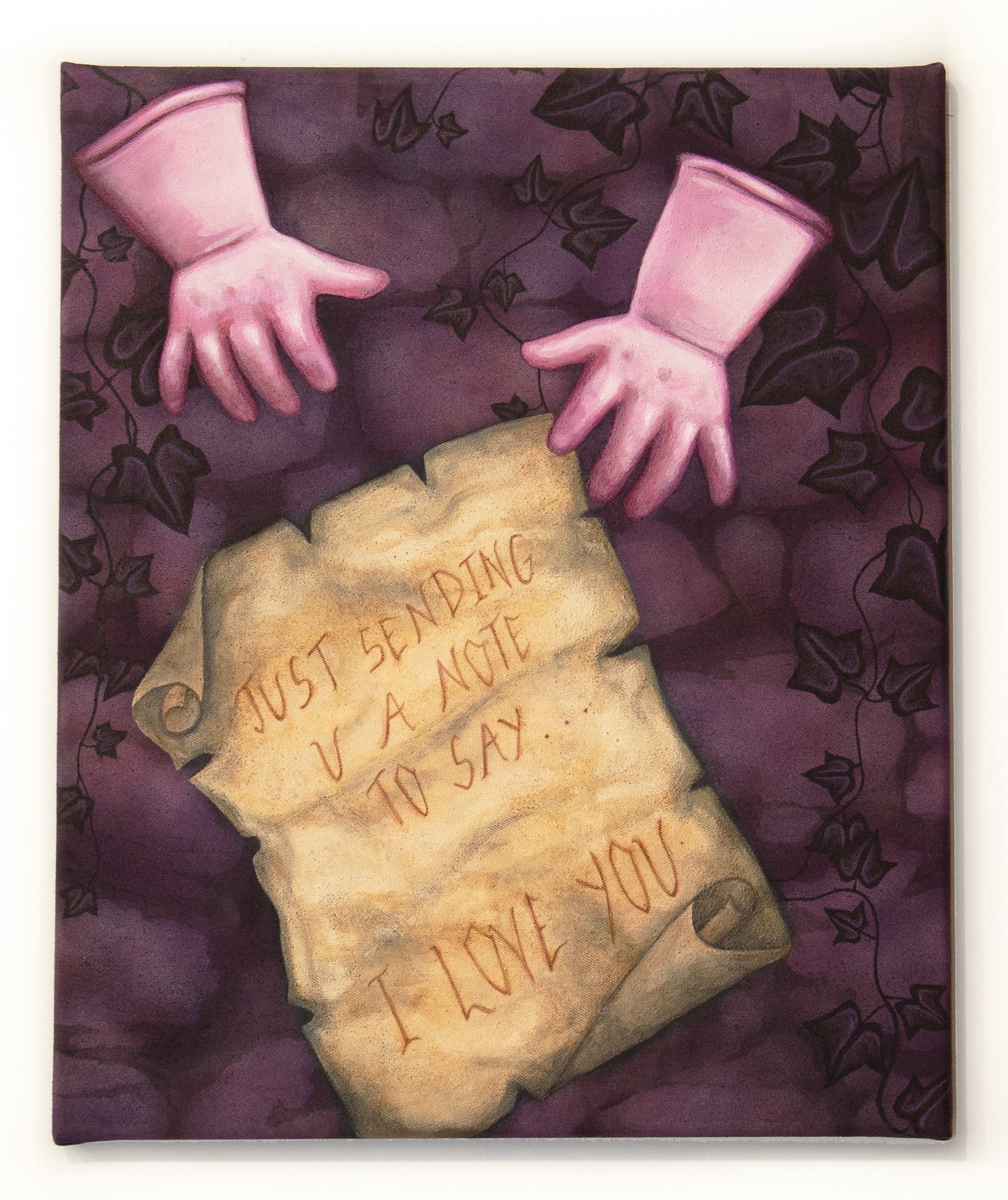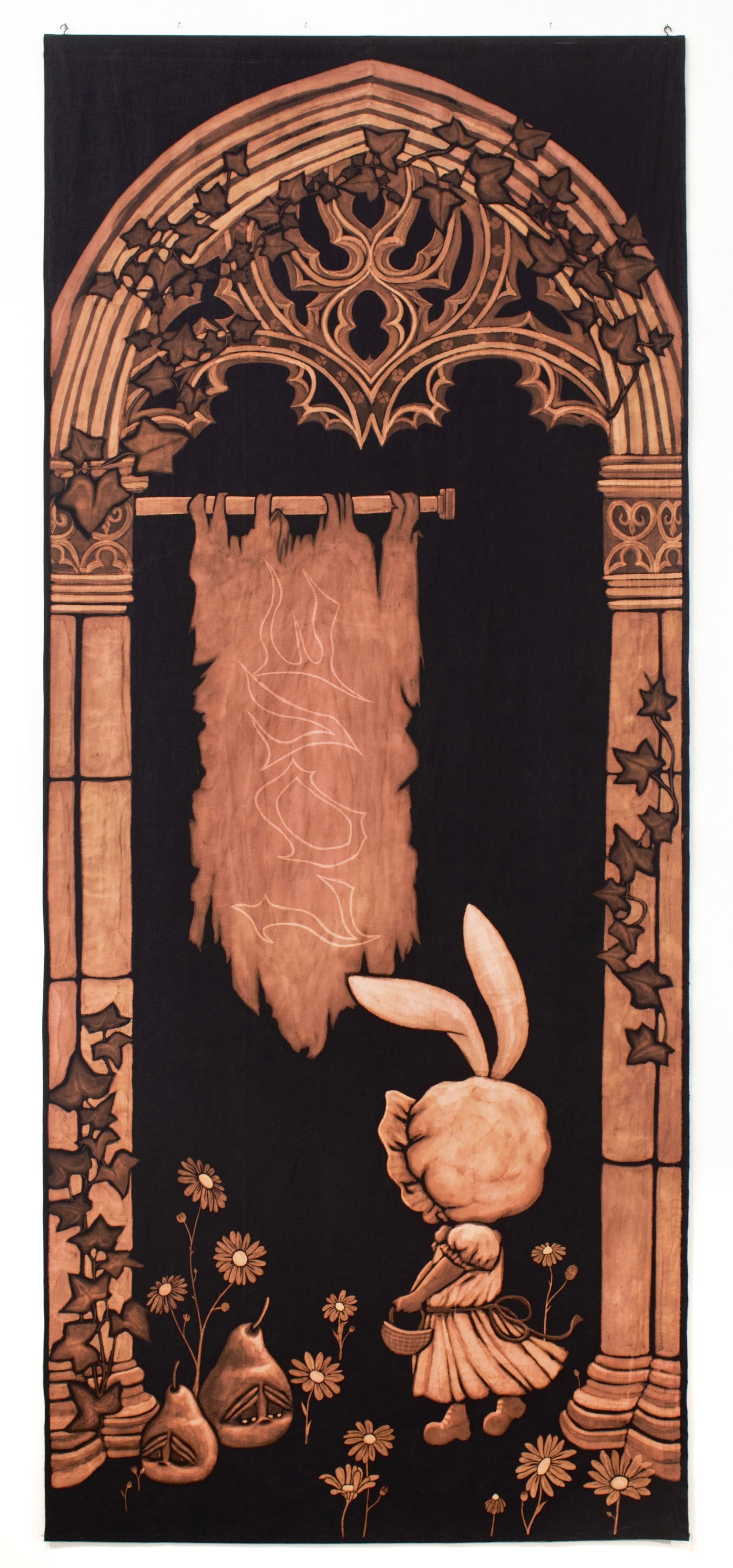Don’t leave me waiting too long
Gaa Projects Cologne
solo exhibition
March 28 - May 27 2023









Withered by-products of the capitalist entertainment machine lay discarded as relics in a thrift shop. Precious Moments dolls, resin cast bears, ceramic puppies, stuffed animals, babies dressed up as rabbits in pastel tones, long ears, puffy tails, and all. Greeting cards are adorned with flowers, hearts, slogans, and promises. Love is thick and deeply etched here, as are the condolences for loss and sickness. Alongside are the celebrations, birthdays, anniversaries, graduations, and holidays.
On the racks hang air-brushed cotton t-shirts, painted leather jackets, and jeans patterned with bleach. There’s a plaque with a cat, wide-eyed, hanging from string tied to a tree on each side. In script, a text reads, “Hang in There”.
Influenced by European art history and globalized pop culture, Padoux’s visual universe resembles a dark fairytale tainted by ennui. Incorporating new and old images, sentimental objects, and a restrained pallet of velvety pink, brown, and yellow overtones, she uses familiar icons to address the power and subversion of cuteness.
Immersed in strange swirls of smoke, ribbon, and ivy, foreboding elements wrap around the inhabitants of Padoux’s paintings. Tattoo script spells out the messages of angels. A child-like figure, more doll than human, is dressed in a rabbit costume. Figures are grounded by cathedral windows and ambiguous suggestions of space. Inspired by Anne Geddes’ photographs of costumed babies, Padoux’s humanoid bunnies prompt questions about our past as humans and the psychological dimension of moving beyond the present and imagining the future. In her eerie renderings of babies swaddled in eggs cracked open, Padoux asks: what will the next generation be born into? What do the legacies of the past determine for future fertility and choice?
Imbued with romantic and gothic fantasy, Padoux’s work in Don’t leave me waiting too long expresses malaise towards the modern world. Nearly but not entirely nostalgic, her work bridges and seeks to upend the dualities of cute vs. serious, feminine vs. masculine. Revealing the multidimensionality of cuteness, Padoux insists on agency and dimensionality. With its requisite sweetness, she engages the subversive power, emotional claim, and resilience of cuteness to transform a hierarchical understanding of art, culture, and identity.
Illustrating a blurred relationship to time, Padoux’s work presents a quest for reconciliation between loss and the search for an ideal.
Influenced by European art history and globalized pop culture, Padoux’s visual universe resembles a dark fairytale tainted by ennui. Incorporating new and old images, sentimental objects, and a restrained pallet of velvety pink, brown, and yellow overtones, she uses familiar icons to address the power and subversion of cuteness.
Immersed in strange swirls of smoke, ribbon, and ivy, foreboding elements wrap around the inhabitants of Padoux’s paintings. Tattoo script spells out the messages of angels. A child-like figure, more doll than human, is dressed in a rabbit costume. Figures are grounded by cathedral windows and ambiguous suggestions of space. Inspired by Anne Geddes’ photographs of costumed babies, Padoux’s humanoid bunnies prompt questions about our past as humans and the psychological dimension of moving beyond the present and imagining the future. In her eerie renderings of babies swaddled in eggs cracked open, Padoux asks: what will the next generation be born into? What do the legacies of the past determine for future fertility and choice?
Imbued with romantic and gothic fantasy, Padoux’s work in Don’t leave me waiting too long expresses malaise towards the modern world. Nearly but not entirely nostalgic, her work bridges and seeks to upend the dualities of cute vs. serious, feminine vs. masculine. Revealing the multidimensionality of cuteness, Padoux insists on agency and dimensionality. With its requisite sweetness, she engages the subversive power, emotional claim, and resilience of cuteness to transform a hierarchical understanding of art, culture, and identity.
Illustrating a blurred relationship to time, Padoux’s work presents a quest for reconciliation between loss and the search for an ideal.